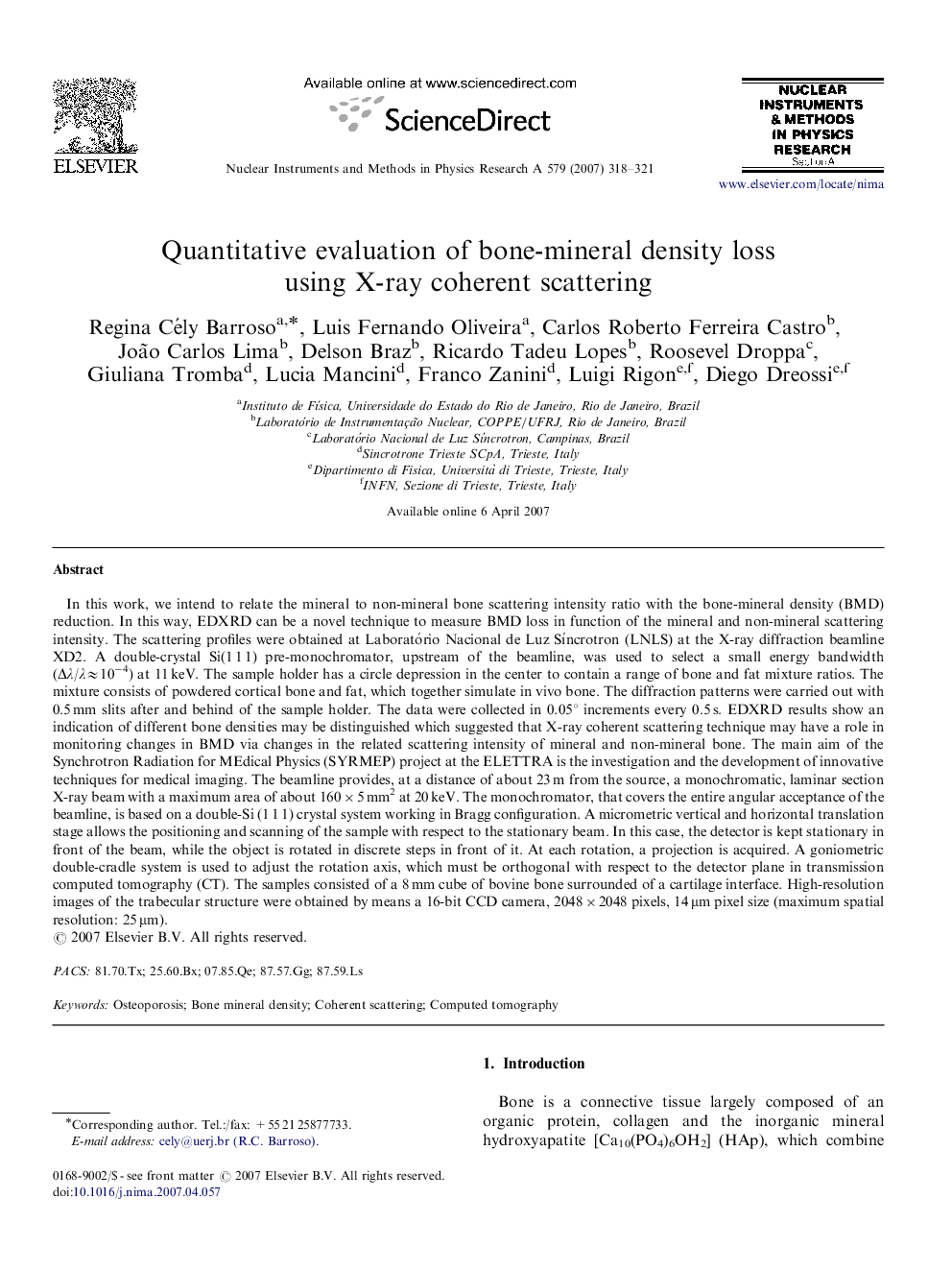| کد مقاله | کد نشریه | سال انتشار | مقاله انگلیسی | نسخه تمام متن |
|---|---|---|---|---|
| 1830736 | 1027483 | 2007 | 4 صفحه PDF | دانلود رایگان |
عنوان انگلیسی مقاله ISI
Quantitative evaluation of bone-mineral density loss using X-ray coherent scattering
دانلود مقاله + سفارش ترجمه
دانلود مقاله ISI انگلیسی
رایگان برای ایرانیان
کلمات کلیدی
موضوعات مرتبط
مهندسی و علوم پایه
فیزیک و نجوم
ابزار دقیق
پیش نمایش صفحه اول مقاله

چکیده انگلیسی
In this work, we intend to relate the mineral to non-mineral bone scattering intensity ratio with the bone-mineral density (BMD) reduction. In this way, EDXRD can be a novel technique to measure BMD loss in function of the mineral and non-mineral scattering intensity. The scattering profiles were obtained at Laboratório Nacional de Luz SÃncrotron (LNLS) at the X-ray diffraction beamline XD2. A double-crystal Si(1 1 1) pre-monochromator, upstream of the beamline, was used to select a small energy bandwidth (Îλ/λâ10â4) at 11 keV. The sample holder has a circle depression in the center to contain a range of bone and fat mixture ratios. The mixture consists of powdered cortical bone and fat, which together simulate in vivo bone. The diffraction patterns were carried out with 0.5 mm slits after and behind of the sample holder. The data were collected in 0.05° increments every 0.5 s. EDXRD results show an indication of different bone densities may be distinguished which suggested that X-ray coherent scattering technique may have a role in monitoring changes in BMD via changes in the related scattering intensity of mineral and non-mineral bone. The main aim of the Synchrotron Radiation for MEdical Physics (SYRMEP) project at the ELETTRA is the investigation and the development of innovative techniques for medical imaging. The beamline provides, at a distance of about 23 m from the source, a monochromatic, laminar section X-ray beam with a maximum area of about 160Ã5 mm2 at 20 keV. The monochromator, that covers the entire angular acceptance of the beamline, is based on a double-Si (1 1 1) crystal system working in Bragg configuration. A micrometric vertical and horizontal translation stage allows the positioning and scanning of the sample with respect to the stationary beam. In this case, the detector is kept stationary in front of the beam, while the object is rotated in discrete steps in front of it. At each rotation, a projection is acquired. A goniometric double-cradle system is used to adjust the rotation axis, which must be orthogonal with respect to the detector plane in transmission computed tomography (CT). The samples consisted of a 8 mm cube of bovine bone surrounded of a cartilage interface. High-resolution images of the trabecular structure were obtained by means a 16-bit CCD camera, 2048Ã2048 pixels, 14 μm pixel size (maximum spatial resolution: 25 μm).
ناشر
Database: Elsevier - ScienceDirect (ساینس دایرکت)
Journal: Nuclear Instruments and Methods in Physics Research Section A: Accelerators, Spectrometers, Detectors and Associated Equipment - Volume 579, Issue 1, 21 August 2007, Pages 318-321
Journal: Nuclear Instruments and Methods in Physics Research Section A: Accelerators, Spectrometers, Detectors and Associated Equipment - Volume 579, Issue 1, 21 August 2007, Pages 318-321
نویسندگان
Regina Cély Barroso, Luis Fernando Oliveira, Carlos Roberto Ferreira Castro, João Carlos Lima, Delson Braz, Ricardo Tadeu Lopes, Roosevel Droppa, Giuliana Tromba, Lucia Mancini, Franco Zanini, Luigi Rigon, Diego Dreossi,